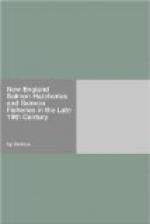The movement for the re-establishment of these fisheries originated in action of the legislature of New Hampshire, seconded by that of the neighboring state of Massachusetts, having in view primarily the fisheries of the Merrimack and Connecticut Rivers. The course of the Merrimack lies wholly within the states of New Hampshire and Massachusetts; that of the Connecticut lies partly in the state of Connecticut, and many of its tributaries are in the state of Vermont. These two states were therefore early interested in the project, and their action soon led to similar exertions on the part of Rhode Island and Maine. Within the borders of the six states mentioned, collectively known as “New England,” are all of the rivers of the United States known to have been frequented by the sea-going Salmo salar, with the possible exception of certain rivers, tributary to the Saint Lawrence, in the northern part of New York.
The governments of these states having appointed boards of commissioners to whom was confided the task of restocking the exhausted rivers, other states, one after another, adopted like measures, and in 1872 the United States Government established a commission to inquire into the condition and needs of the fisheries in general, with authority to take steps for the propagation of food fishes.
The New England commissioners turned their attention at once to the two most important of their migratory fishes, the salmon and the shad. The utter extermination of salmon from most of their rivers compelled them to consider the best mode of introducing them from abroad.
Agents were sent to the rivers of Canada, where for several years they were permitted to take salmon from their spawning beds, and some hundreds of thousands of salmon eggs were thus obtained and hatched with a measure of success. After a few seasons permits for such operations were discontinued, and the only foreign source of supply thereafter remaining open to the states was found in the breeding establishments under control of the Canadian Government, and even these were practically closed by the high price at which the eggs were valued.
In 1870 it had become clear that to a continuation of efforts it was essential that a new supply of salmon ova should be discovered. Attention was now directed to the Penobscot River in the state of Maine, which, though very unproductive compared with Canadian rivers, might yet, perhaps, be made to yield the requisite quantity of spawn.
A preliminary examination of the river brought out the following facts: The Penobscot is about 225 miles in length. The upper half of its course and nearly all of its principal tributaries lie in an uninhabited wilderness, and in this district are the breeding grounds of the salmon. The fisheries, however, are all on the lower part of the river and in the estuary into which it empties, Penobscot Bay. There was no means of knowing how great a proportion of the salmon entering this river succeeded in passing safely the traps and nets set to intercept them, but supposing half of them to escape capture there would still be but about 6,000 fish of both sexes scattered through the hundreds of miles of rivers and streams forming the headwaters of the Penobscot.




